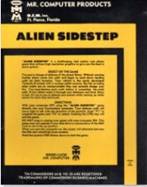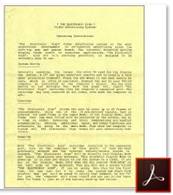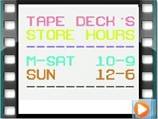|
At Dictaphone I was using authentic Apple II computers for my development work. At some point I bought real ones myself. I noticed that one of the Dictaphone accessories we made was a speaker in a nice plastic sloped-front housing. The color went very well with the Apple II case.
One problem with the Apple’s sound was that it had a tiny transistor radio sized speaker in the cabinet facing down. It originally was for nothing more than beeps, but programmers were now getting all sorts of sounds out of it. Not only that, but the speakers we were using in the Dictaphone accessory was extremely efficient. I unplugged an Apple’s internal speaker and plugged in one of these, and the sound was really great. It was a huge improvement without any circuitry or power needed. It was so good that I added a low impedance pot to adjust the volume.
I asked at work and they couldn’t think of any reason not to make me a customer. So, I contracted them to build 50 with a custom front panel and silkscreen it “Speaker II”.
My mother was a technical graphics artist. She put together a very nice ad which we placed in “Computer Shopper”. At the time a huge thick newsprint magazine covering everything about computers. We did get quite a few orders from all over, even overseas. But, the reality was that it was just too late. The Apple II was aging by then and people were not really upgrading the ones they had. If I had done this 5 years sooner we probably would have sold thousands. So, it was the usual financial loss.
|

|
Alien Sidestep - Video Game Cartridge for the Commodore VIC20 & C64 (1983) |

|
Electronics - Products & Misc. (page 1) |
|
Before I talk about my video game, the real story here is that I always wanted my own business. My ultimate goal was to design a product, manufacture it and sell it. If I could have one success, I could build on it with more products. Well, it never happened or even came close. I suppose it would be fair to say the contract engineering I did was kind of my own business, but that’s really stretching it. That was just me working by the hour on someone else’s vision.
The main problem is that I often think of ideas, have the skills to develop and design them, build the prototype and even write up manuals and brochures. But there I get stuck. I don’t have the promoter in me. Apple took off because Wozniak designed and Jobs sold. I never was nor had access to a “Jobs”.
Alien Sidestep was slightly profitable for me (slight is an exaggeration, miniscule would be more descriptive). The only reason I even profited was that for the only time in my many entrepreneurial disasters, I had an existing company promote & sell it.
|




|
I had already created a cartridge for the VIC20 which I called “The Electronic Sign” in 1981 (write-up above). It’s too bad I didn’t start with my game, because had I come out with it a year earlier, I could have made some real money. By the time I finished Alien Sidestep and found a company to put it out, this particular wave of home video games was just about over. The guys at Mr. Computer Products were very impressed with my game and told me how much another game had sold the previous year and that mine was much better.
I was really just writing the game for my own amusement. I had built an EPROM emulator pod that was driven by an interface bd. I built for my Apple II clone. I couldn’t afford real Apple IIs, so I used Japanese clone bare boards and built my own. I also bought a 5” CRT and built my own portable Apple II as well. I used the “SC Macro Assembler” to write the software. The people there were helpful and after I explained my EPROM emulator they told me what bytes to patch in their assembler so that the binary would be sent out to my pod directly when I gave the “assemble” command. This gave me an incredibly fast and efficient tool path and I never had to hesitate to use the trial and error method when I needed to. I used more of my pods at work with real Apple IIs to develop products.
I signed the contract for them to produce & sell Alien Sidestep on May 7, 1983 (the day before my 27th birthday). It stipulated that rights would return to me whenever proceeds dropped below a minimum amount, which happened all too soon. Part of my payment was a new Commodore 64 computer that they gave me with the provision that I write a version for it. I worked on this, making it as close to to the VIC20 version as possible. They said they had never seen a game look so much alike on both machines.
I’ve noticed retro-game sites reviewing my game say that it takes RAM expansion in order to run. This is all wrong, and I suspect it’s a result of whatever hack let them bootleg the code. Also they think it should be more varied. Well, they only gave me a 4K EPROM for the entire game, so all the code and bitmaps of the various elements had to fit in that space, which was pretty small even for 1983. My only choice to have it increase in difficulty was to make it go faster as you go through the levels.
|






|
The Electronic Sign - Store Countertop Or Window Advertising System (1981) |
|
Part 1: The VIC20 computer was designed to use your home TV set as a monitor. At about the same time, medium size 19” color TVs were becoming less expensive. So, before I even purchased a VIC20, I had the idea to create an advertising system for stores. They would place a 19” color TV either on a countertop or in the front window and run a cable to the computer. Software would let you compose advertising text and then present it on the screen using multi-sized, colorful fonts. In between screens would be attention getting graphics. Well, I bought the VIC20 and started playing with it. I soon realized I couldn’t develop a complex program on the VIC20 itself as there simply was not enough memory and the only storage system was cassette tape.
For my first computer, I had wanted an Apple II but that was completely out of the question. I had only been working for less than a year and I had to get a loan just to buy my first oscilloscope! The next best thing was a Radio Shack TRS-80 Model 1. I had to buy the cheapest one possible from a discounter by mail in order to afford it. To expand memory and provide a floppy interface, I bought a Japanese bare board copy of the TRS80 expansion chassis and built it myself. While the TRS80 was just monochrome, it was pretty powerful for the time and had a really nice Basic built in. It also had 64 columns of text which looked pretty decent on it’s dedicated monitor. To facilitate all the experiments I wanted to do, I came up with my own bus card cage. I designed a serial port, 300 baud modem, tone generators, EPROM programmer, ham RTTY interface and lots of other boards which I would plug into the chassis’ bus.
This is how it all came together. In TRS80 Basic, I wrote a complete 6502 cross assembler. I would use the system’s normal text editor, which was pretty versatile, then run my assembler. The bytes would be sent out through my custom bus, through a card I dedicated as a driver, over flat cable to my first EPROM emulator design. The data would be written into the emulator’s RAM. On the “other side”, the emulator had a cable with a DIP plug which plugged into a RAM / EPROM expansion bd. I had designed for the VIC20. So, I could write my 6502 assembly language routines on the TRS80, use my cross-assembler to generate the bytes which got sent through my driver bus card to my EPROM emulator. Flip the switch and it was now on the VIC20 bus. It was very efficient and that’s how I wrote the first version of “The Electronic Sign”.
At various times I would use the programmer I had built on one of my bus cards to burn an actual EPROM and put that in the VIC20 to test it completely stand-alone. Now the only way to store anything you did on the VIC20 was on a cassette tape. That was slow and miserable. I wanted to store all the text and other selections that the store owner would be entering. It couldn’t go away every time you turn off your computer or there’s a power glitch. EEPROM in that size was not yet an option. So, I modified one of my VIC20 RAM / EPROM expansion boards to let lo-power RAM be held up using a small NiCad battery. I used minimal circuitry to just trickle charge the battery when the computer was on. It would hold up the RAM contents for weeks without powering up the computer.
When it got to the point that it was doing most of what I wanted, I started to think about how I would sell this. For one thing, the TV would most likely not be visible where the computer would be located. So, I decided that I would sell the system with a 9” monochrome monitor that would always be with the VIC20. I chose a very nice Panasonic unit and ordered one. The next problem was how much hardware was accumulating. There’s the VIC20, it’s external power module, the 9” monitor, the RF modulator, the 19” TV and all the cables. Also, I wondered about offering this system based around the not-so-professional looking VIC20. Then there was the cost of it all. At some point I made the terrible decision to stop and design a completely dedicated computer.
All of the ICs in the VIC20 could be purchased. Even the VIC video chip could be bought from MOS Technology along with the 6502 µP. I essentially copied the VIC20 design while changing the way the bus was driven and leaving out parts I didn’t need. I hand-wired the entire thing on about 6 Radio Shack breadboards sliced and screwed together (see photos). For that matter, in those days anything I designed got hand wired. Prototype PCBs were crazy expensive. I only had that luxury for projects at work.
I made changes to my Electronic Sign software that eliminated any calls to the VIC20 operating system. My software now was the only thing installed so it would begin executing at reset. I started to design an enclosure that would house this computer, the keyboard, RF modulator and it’s own AC power supply. I wanted it to be strong enough to support the 9” monitor on top to make one cohesive package. But, the cost of having PCBs made scared me. So, I had to backtrack and make provisions to let the VIC20’s electronics mount inside to get me started. I thought selling some systems where I had to pull VIC20 boards out of computers was much cheaper than building my new computer from scratch. If it caught on, I would just have my version fit in the same footprint and bring my costs way down.
I took the design to work where a mechanical engineer friend of mine did formal drawings. Then I paid Dictaphone to build me a short run. They had a huge metal fab shop and made most of their own enclosures. It was way-way over engineered. I wanted to sit the monitor on top of it, so we used steel. Also it was large in order to have the keyboard in front and the PCB in the back. I had to use an OEM raw keyboard and hand wire the matrix. And even though I was starting out still using the VIC20 motherboard, I went with my later software that takes over completely so I could just put my EPROM where Commodore’s ROMs would go. So now I had to have my software scan the keyboard continuously and convert it to characters since I had dumped the operating system.
The whole thing kind of got out of hand. I would come home for work and then put in another 6 or more hours. In the end, I did have one whole system working perfectly. Now, really for the first time, I do what will become a life long pattern. I hit the wall. I had the idea, did the development and built the prototype. Now it has to be sold. I’m dead.
I went on to create some early documentation and put together a presentation. I went to a record store in Melbourne, “The Tape Deck” and asked if I could demonstrate my system. They agreed, so I brought in all the equipment, 19” CRT TV and all. I had preprogrammed mock sales screens, etc. They were very impressed, and I quoted them a price that would barely cover what the equipment cost me. No sale!
It was a monumental task to bring this thing around door to door to sell it. I just didn’t know what to do. So, like all my other entrepreneurial ventures (read: failures) yet to come, it went on the shelf. |








|
Prototype of my cartridge for the VIC20 version of “The Electronic Sign”. |
|
Commercially released cartridge as made by OEM Inc. / Mr. Computer Products |

|
Internal photo of cartridge shows EPROMs, lo-power RAM and NiCad battery. |

|
Part 2: With “The Electronic Sign” in both VIC20 cartridge and my custom stand-alone computer versions on the shelf, somehow I decided to write a video game. At first, it was just for my own amusement. When I showed it to my friends, they thought I should actually sell it. The “Alien Sidestep” story follows in the next section.
After selling Alien Sidestep to OEM Inc. / Mr. Computer Products, I told them about “The Electronic Sign”. The were curious, so I demonstrated my VIC20 cartridge version prototype. They were very impressed and gave me a contract to sell it too. So, really Part 2 of this story comes after Alien Sidestep chronologically. The photo shows the cartridge they produced and sold. But like everything else, it was just a bit too late and sales were pretty slim.
In the mean time, I had switched to my Apple II clones to develop “Alien Sidestep” (explained below). To keep everything consistent, I sent my TRS80 source text for “The Electronic Sign” over RS232 to the Apple. Then I edited it to match the syntax of that assembler and from then on maintained it on the Apple.
|

|
Speaker II - External Speaker For The Apple II (1985) |




